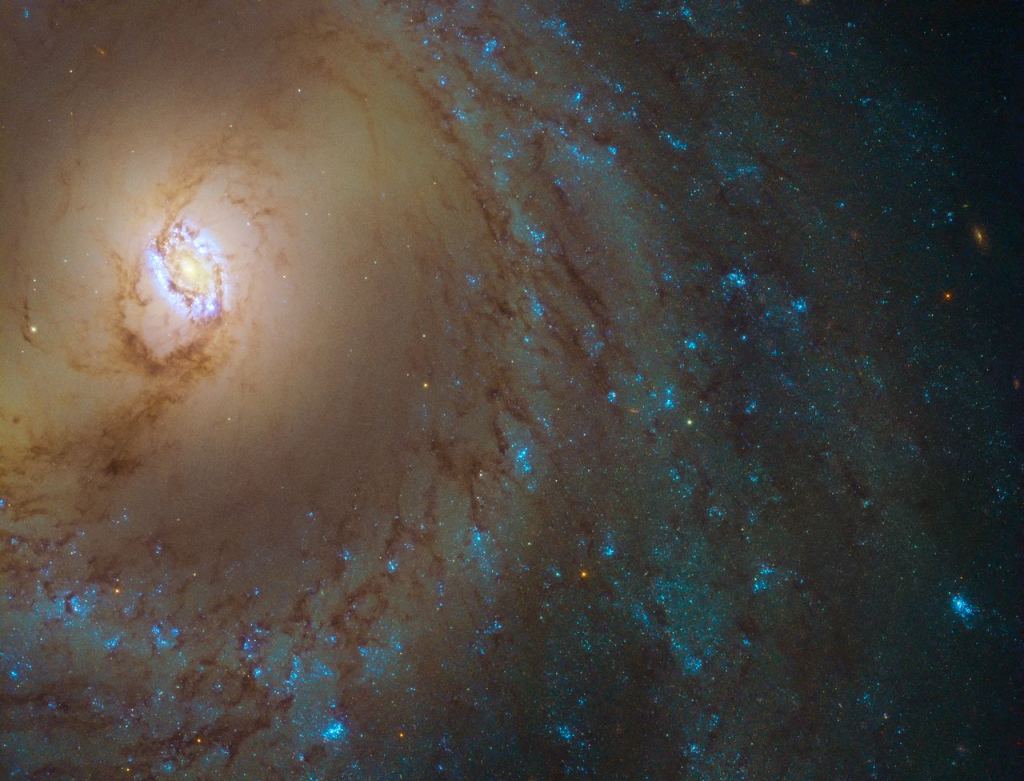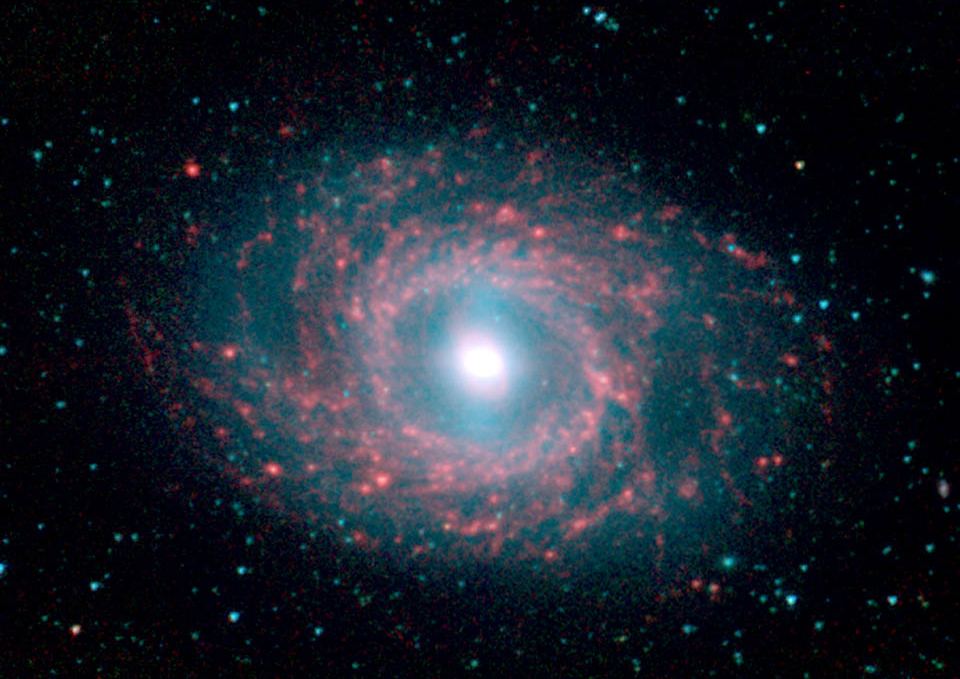Messier 95 – the NGC 3351 Barred Spiral Galaxy
By Tammy Plotner
Welcome back to Messier Monday! Today, we continue in our tribute to our dear friend, Tammy Plotner, by looking at the barred spiral gaxaxy known as Messier 95!
During the 18th century, famed French astronomer Charles Messier noticed the presence of several “nebulous objects” while surveying the night sky. Originally mistaking these objects for comets, he began to catalog them so that others would not make the same mistake. Today, the resulting list (known as the Messier Catalog) includes over 100 objects and is one of the most influential catalogs of Deep Space Objects.
One of these objects is Messier 95 (aka. NGC 3351), a barred spiral galaxy located about 33 million light-years away. Measuring over 80,000 light-years, or 24.58 kiloparsecs (kpc) in diameter, this galaxy is one of several that fall into the M96 Group, located in the constellation Leo. This Group consists of between 8 and 24 galaxies in total, and three additional Messier Objects: M95, M96 and M105.
What You Are Looking At:
Located about 38 million light years away, M95 was one of the galaxies in the key project of the Hubble Space Telescope for the determination of the Hubble constant: the HST was employed to look for Cepheid variable stars and thereby determine this galaxy’s distance. As Joseph Jensen (et al) indicated in a 2003 paper:
“To empirically calibrate the IR surface brightness fluctuation (SBF) distance scale and probe the properties of unresolved stellar populations, we measured fluctuations in 65 galaxies using NICMOS on the Hubble Space Telescope. The early-type galaxies in this sample include elliptical and S0 galaxies and spiral bulges in a variety of environments. Absolute fluctuation magnitudes in the F160W (1.6 um) filter (MF160W) were derived for each galaxy using previously measured I-band SBF and Cepheid variable star distances. F160W SBFs can be used to measure distances to early-type galaxies with a relative accuracy of ~10%, provided that the galaxy color is known to ~0.035 mag or better. Near-IR fluctuations can also reveal the properties of the most luminous stellar populations in galaxies.”

“Comparison of F160W fluctuation magnitudes and optical colors to stellar population model predictions suggests that bluer elliptical and S0 galaxies have significantly younger populations than redder ones and may also be more metal-rich. There are no galaxies in this sample with fluctuation magnitudes consistent with old, metal-poor (t>5 Gyr, [Fe/H]<-0.7) stellar population models. Composite stellar population models imply that bright fluctuations in the bluer galaxies may be the result of an episode of recent star formation in a fraction of the total mass of a galaxy. Age estimates from the F160W fluctuation magnitudes are consistent with those measured using the HB Balmer-line index. The two types of measurements make use of completely different techniques and are sensitive to stars in different evolutionary phases. Both techniques reveal the presence of intermediate-age stars in the early-type galaxies of this sample.”
One of the most beautiful aspects of M95 is it’s bright core, but what goes on inside? As Luis Colina (et al) noted in a 1997 study:
“A high-resolution Hubble Space Telescope WFPC2 F218W UV image of the barred spiral NGC 4303 (classified as a LINER-type active galactic nucleus [AGN]) reveals for the first time the existence of a nuclear spiral structure of massive star-forming regions all the way down to the UV-bright unresolved core (size <= 8 pc) of an active galaxy. The spiral structure, as traced by the UV-bright star-forming regions, has an outer radius of 225 pc and widens as the distance from the core increases. The UV luminosity of NGC 4303 is dominated by the massive star-forming regions, and the unresolved LINER-type core contributes only 16% of the integrated UV luminosity. The nature of the UV-bright LINER-type core—stellar cluster or pure AGN—is still unknown.”
“In contrast to NGC 4303, the UV F218W image of the non-AGN barred galaxy NGC 3351 shows a nuclear star-forming ring of 315 pc (semimajor axis) with a faint core. In the ring, the star formation is arranged in clumps of about 60–85 pc in diameter. Each clump consists of a few compact UV-bright clusters embedded in a more diffuse component. The integrated IUE spectrum of NGC 3351 shows the presence of Si IV 1400 A and C IV 1550 A absorption lines, typical features of young, 4–5 Myr old, massive star clusters. The presence of ring and spiral star-forming structures in the nuclear regions of these two barred spirals supports the bar-induced gas-fueling scenario by which bars accumulate gas in the nuclear regions of galaxies, produce nuclear star-forming rings (NGC 3351), and might eventually generate or feed an AGN (NGC 4303).”

The most recent supernova (SN 2012aw) in this galaxy was observed in 2012. This supernova was visible on one of the galaxy’s spiral arms, and was quickly confirmed to be the result of star undergoing core collapse at the end of its life cycle (a Type II supernova). Observations of this explosion provided astronomers with the first opportunity to view the “UV plateau” of a Type II supernova. As Bayless (et al.) wrote in a 2013 paper:
“Observations with the Swift UV Optical Telescope have unambiguously uncovered for the first time a long-lived, UV ‘plateau’ in a Type II-P supernova (SN). Although this flattening in slope is hinted at in a few other SNe, due to its proximity and minimal line-of-sight extinction, SN 2012aw has afforded the first opportunity to clearly observe this UV plateau. The observations of SN 2012aw revealed all Swift UV and u-band light curves initially declined rapidly, but 27 days after the explosion the light curves flattened. Some possible sources of the UV plateau are the same thermal process that causes the optical plateau, heating from radioactive decay, or a combination of both processes.”
In a recent study, Morgan Fraser (Univ. of Cambridge) presented reexamined near-infrared data of SN 2012aw and concluded that it was the result of a collapsing red supergiant of between 11 to 15 Solar masses:
“We present new late-time near-infrared imaging of the site of the nearby core-collapse supernova SN 2012aw, confirming the disappearance of the point source identified by Fraser et al. (2012) and Van Dyk et al. (2012) as a candidate progenitor in both J and Ks filters. We remeasure the progenitor photometry, and find that both the J and Ks magnitudes of the source are consistent with those quoted in the literature. We also recover a marginal detection of the progenitor in H-band, for which we measure H=19.67±0.40 mag. Comparing the luminosity of the progenitor to stellar evolutionary models, SN 2012aw appears to have resulted from the explosion of a 12.5±1.5 M red supergiant.”

History of Observation:
This pretty galaxy was first discovered by Pierre Mechain in 1781 and cataloged by Charles Messier 4 days later on March 24th, 1781. As Messier wrote of it: “Nebula without star, in the Lion [Leo], above star l (53 Leonis): its light is very faint.” On March 11th, 1784, Sir William Herschel would also take note of it, writing: “A fine, bright nebula, much brighter in the middle than at the extremes, of a pretty considerable extent, perhaps 3 or 4′ or more. The middle seems to be of the magnitude of 3 or 4 stars joined together, but not exactly round; from the brightest part of it there is a sudden transition to the nebulous part, so that I should call it cometic.”
It would nearly 100 years later when Admiral Smyth would most aptly decribe M95 as:
“A lucid white nebula, on the lion’s ribs, with only two small stars, np [north preceding, NW] and nf [north following, NE], in the field. Its place is almost due east of Regulus, with a distance of 9 deg, where it forms the southern vertex of a triangle nearly equilateral with Gamma and Delta Leonis. This nebula is round and bright, and perhaps better defined on the southern than on the northern limb, a phenomenon worthy to remark, and observable in the great nebula of Andromeda [M31], and other wonderful masses.
“It was discovered by Mechain in 1781, and registered by Messier as a ‘feeble nebula, without a star.’ Nearly a degree to the eastward of this object, follows another round but not equally well defined nebula, large, and of a pale white colour. It is Messier’s No. 96, and was also discovered by Mechain in 1781; it constitutes the intersecting point of a rectangle formed by five stars, of which the nearest is in the sp [south preceding] quadrant, and of the 11th magnitude.”

Locating Messier 95:
M95 is the southernmost in the widefield eyepiece pairing of galaxies which includes M96. With good sky conditons, both M95 and M96 are easy to locate in the belly of the constellation of Leo. Begin by identifying Alpha (Regulus), the brightest, southernmost star in the backwards question mark asterism. Now, look about a fistwidth west where you will see the shallow triangle asterism which marks Leo’s hips. The westernmost of these stars (Theta) is your next marker. Look between the two markers for a faint star in an almost central position.
If the skies are right to see this galactic pair, you will also see another star just south of your last marker. M95 and M96 are between these last two stars. The pair can just barely be seen in larger binoculars and although they are faint, perceivable in a small telescope. Larger aperture will bring out far more details. Because these are fainter galaxies, the require a dark sky location and cannot tolerate background glow, such as moonlit nights.
And here are the quick facts on this Messier Object to help get you started:
Object Name: Messier 95
Alternative Designations: M95, NGC 3351
Object Type: Type SBb Barred Spiral Galaxy
Constellation: Leo
Right Ascension: 10 : 44.0 (h:m)
Declination: +11 : 42 (deg:m)
Distance: 38000 (kly)
Visual Brightness: 9.7 (mag)
Apparent Dimension: 4.4×3.3 (arc min)
We have written many interesting articles about Messier Objects here at Universe Today. Here’s Tammy Plotner’s Introduction to the Messier Objects, M1 – The Crab Nebula, M8 – The Lagoon Nebula, and David Dickison’s articles on the 2013 and 2014 Messier Marathons.
Be sure to check out our complete Messier Catalog. And for more information, check out the SEDS Messier Database.
Sources:
The post Messier 95 – the NGC 3351 Barred Spiral Galaxy appeared first on Universe Today.

December 7, 2021 at 01:37AM
via Universe Today read more...

Post a Comment